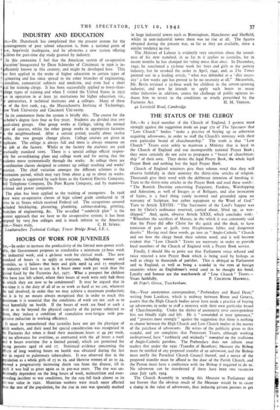HOURS OF WORK FOR JUVENILES
tit,—In order to increase the productivity of the limited man-power avail- ble, the Government proposes to standardise a minimum 52-horn week
✓ industrial work, and a 46-hour week for clerical work. This new andard of hours is to apply to everyone, including women and veniks, so it follows that boys and girls aged 14 and 15 employed industry will have to put in 8 hours more work per week than the riod fixed by the Factories Act, 1937. What a prospect for children ho have just left school, where their hours of work were only half those which they are now to be condemned! It may be argued that in r-time it is the duty of all of us to work as hard as we can, whatever e toil involved, in order that we may achieve a maximum production; ut it is by no means always recognised that in order to reach this aximum it is essential that the conditions of work are not such as to act harmfully on health. If the hours of work are fixed at such a vel as to be beyond the physical capacity of the person subjected to em, they induce a condition of cumulative over-fatigue with pro- essive reduction in working efficiency. __ It must be remembered that juveniles have not got the physique of dult workers, and their need for special consideration was recognised in e Factories Act when it fixed their maximum hours at 44 per week, d no allowance for overtime, as contrasted with the 48 hours a week d 6 hours overtime (for a limited period), which are permitted for oung persons aged 16 and 17. Statistical evidence concerning the ects of long working hours on health was obtained during the last ar in regard to pulmonary tuberculosis. It was observed that in the ulation as a whole girls of 15 to 19, and likewise women of 20 to 24, wed a progressively increasing death rate from the disease, till in 918 it was half as great again as in pre-war years. The rise was un- ubtedly dependent on the long hours of work, malnutrition and over- owding_incident to war conditions, for the rate fell back almost to its re-war value in 1920. Munition workers were much more affected an the rest of the population, for the rise in rate was specially marked in large industrial towns such as Birmingham, Manchester and Sheffield, whilst in non-industrial towns there was no rise at all. The figures obtained during the present war, so far as they are available, show a similar tendency to rise.
The Minister of Labour is evidently very uncertain about the sound- ness of his new standard, in so far as it applies to juveniles, for in recent months he has changed his -uling mote than once. In December, 1941, he sanctioned a 53-hour week for boys and girls in the pottery industry, but he revoked the order in April, 1942, and, as The Times pointed out in a leading article, " what was defended as a ' dire neces- sity' a few weeks ago has proved to be no necessity at all." Meanwhile, Mr. Bevin retained a 52-hour week for children in the cotton-spinning industry, and now he intends to apply such hours to many other industries in addition, unless the challenge of public opinion in- duces him to revert to the conditions so wisely prescribed by the


























 Previous page
Previous page